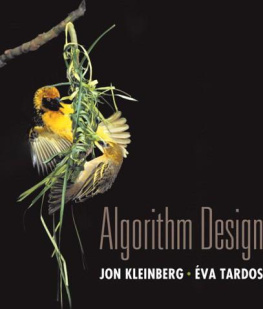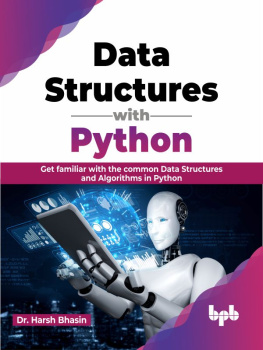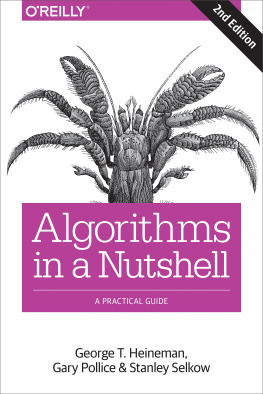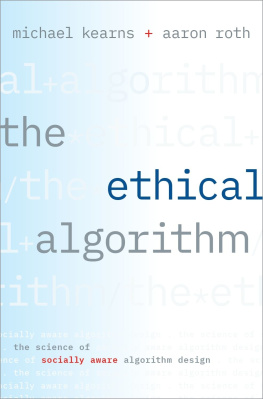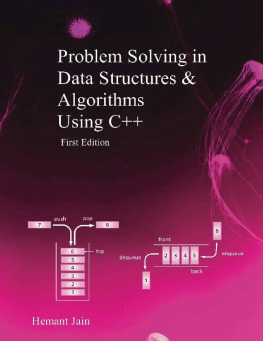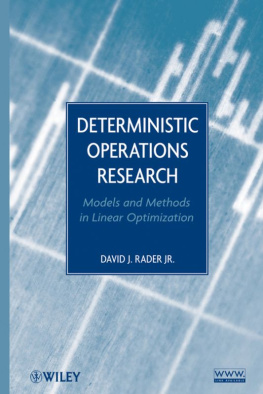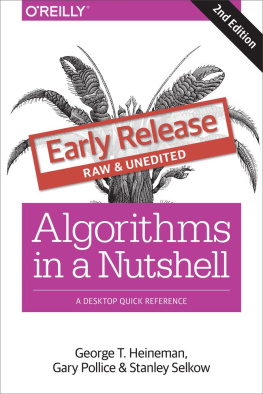Algorithm Design
JON KLEINBERG VA TARDOS
Cornell University

Boston San Francisco New York
London Toronto Sydney Tokyo Singapore Madrid
Mexico City Munich Paris Cape Town Hong Kong Montreal
Acquisitions Editor: Matt Goldstein
Project Editor: Maite Suarez-Rivas
Production Supervisor: Marilyn Lloyd
Marketing Manager: Michelle Brown
Marketing Coordinator: Jake Zavracky
Project Management: Windfall Software
Composition: Windfall Software, using ZzTEX
Copyeditor: Carol Leyba
Technical Illustration: Dartmouth Publishing
Proofreader: Jennifer McClain
Indexer: Ted Laux
Cover Design: Joyce Cosentino Wells
Cover Photo: 2005 Tim Laman / National Geographic. A pair of weaverbirds work together on their nest in Africa.
Prepress and Manufacturing: Caroline Fell
Printer: Courier Westford
Access the latest information about Addison-Wesley titles from our World Wide Web site: http://www.aw-bc.com/computing
Many of the designations used by manufacturers and sellers to distinguish their products are claimed as trademarks. Where those designations appear in this book, and Addison-Wesley was aware of a trademark claim, the designations have been printed in initial caps or all caps.
The programs and applications presented in this book have been included for their instructional value. They have been tested with care, but are not guaranteed for any particular purpose. The publisher does not offer any warranties or representations, nor does it accept any liabilities with respect to the programs or applications.
Library of Congress Cataloging-in-Publication Data
Kleinberg, Jon.
Algorithm design / Jon Kleinberg, va Tardos.1st ed.
p. cm.
Includes bibliographical references and index.
ISBN 0-321-29535-8 (alk. paper)
1. Computer algorithms. 2. Data structures (Computer science) I. Tardos, va. II. Title.
QA76.9.A43K54 2005
005.1dc22 2005000401
Copyright 2006 by Pearson Education, Inc.
For information on obtaining permission for use of material in this work, please submit a written request to Pearson Education, Inc., Rights and Contract Department, 75 Arlington Street, Suite 300, Boston, MA 02116 or fax your request to (617) 848-7047.
All rights reserved. No part of this publication may be reproduced, stored in a retrieval system, or transmitted, in any form or by any means, electronic, mechanical, photocopying, recording, or any toher media embodiments now known or hereafter to become known, without the prior written permission of the publisher. Printed in the United States of America.
ISBN 0-321-29535-8
1 2 3 4 5 6 7 8 9 10-CRW-08 07 06 05
About the Authors
Jon Kleinberg is a professor of Computer Science at Cornell University. He received his Ph.D. from M.I.T. in 1996. He is the recipient of an NSF Career Award, an ONR Young Investigator Award, an IBM Outstanding Innovation Award, the National Academy of Sciences Award for Initiatives in Research, research fellowships from the Packard and Sloan Foundations, and teaching awards from the Cornell Engineering College and Computer Science Department.
Kleinberg's research is centered around algorithms, particularly those concerned with the structure of networks and information, and with applications to information science, optimization, data mining, and computational biology. His work on network analysis using hubs and authorities helped form the foundation for the current generation of Internet search engines.
va Tardos is a professor of Computer Science at Cornell University. She received her Ph.D. from Etvs University in Budapest, Hungary in 1984. She is a member of the American Academy of Arts and Sciences, and an ACM Fellow; she is the recipient of an NSF Presidential Young Investigator Award, the Fulkerson Prize, research fellowships from the Guggenheim, Packard, and Sloan Foundations, and teaching awards from the Cornell Engineering College and Computer Science Department.
Tardos's research interests are focused on the design and analysis of algorithms for problems on graphs or networks. She is most known for her work on network-flow algorithms and approximation algorithms for network problems. Her recent work focuses on algorithmic game theory, an emerging area concerned with designing systems and algorithms for selfish users.
Contents
Preface
Algorithmic ideas are pervasive, and their reach is apparent in examples both within computer science and beyond. Some of the major shifts in Internet routing standards can be viewed as debates over the deficiencies of one shortest-path algorithm and the relative advantages of another. The basic notions used by biologists to express similarities among genes and genomes have algorithmic definitions. The concerns voiced by economists over the feasibility of combinatorial auctions in practice are rooted partly in the fact that these auctions contain computationally intractable search problems as special cases. And algorithmic notions aren't just restricted to well-known and longstanding problems; one sees the reflections of these ideas on a regular basis, in novel issues arising across a wide range of areas. The scientist from Yahoo! who told us over lunch one day about their system for serving ads to users was describing a set of issues that, deep down, could be modeled as a network flow problem. So was the former student, now a management consultant working on staffing protocols for large hospitals, whom we happened to meet on a trip to New York City.
The point is not simply that algorithms have many applications. The deeper issue is that the subject of algorithms is a powerful lens through which to view the field of computer science in general. Algorithmic problems form the heart of computer science, but they rarely arrive as cleanly packaged, mathematically precise questions. Rather, they tend to come bundled together with lots of messy, application-specific detail, some of it essential, some of it extraneous. As a result, the algorithmic enterprise consists of two fundamental components: the task of getting to the mathematically clean core of a problem, and then the task of identifying the appropriate algorithm design techniques, based on the structure of the problem. These two components interact: the more comfortable one is with the full array of possible design techniques, the more one starts to recognize the clean formulations that lie within messy problems out in the world. At their most effective, then, algorithmic ideas do not just provide solutions to well-posed problems; they form the language that lets you cleanly express the underlying questions.
The goal of our book is to convey this approach to algorithms, as a design process that begins with problems arising across the full range of computing applications, builds on an understanding of algorithm design techniques, and results in the development of efficient solutions to these problems. We seek to explore the role of algorithmic ideas in computer science generally, and relate these ideas to the range of precisely formulated problems for which we can design and analyze algorithms. In other words, what are the underlying issues that motivate these problems, and how did we choose these particular ways of formulating them? How did we recognize which design principles were appropriate in different situations?
In keeping with this, our goal is to offer advice on how to identify clean algorithmic problem formulations in complex issues from different areas of computing and, from this, how to design efficient algorithms for the resulting problems. Sophisticated algorithms are often best understood by reconstructing the sequence of ideasincluding false starts and dead endsthat led from simpler initial approaches to the eventual solution. The result is a style of exposition that does not take the most direct route from problem statement to algorithm, but we feel it better reflects the way that we and our colleagues genuinely think about these questions.
Next page
